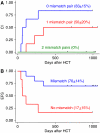Inhibitory KIR-HLA receptor-ligand mismatch in autologous haematopoietic stem cell transplantation for solid tumour and lymphoma
- PMID: 17667923
- PMCID: PMC2360345
- DOI: 10.1038/sj.bjc.6603913
Inhibitory KIR-HLA receptor-ligand mismatch in autologous haematopoietic stem cell transplantation for solid tumour and lymphoma
Abstract
Genes that encode killer Ig-like receptors (KIRs) and their HLA class I ligands segregate independently; thus, some individuals may express an inhibitory KIR gene but not its cognate ligand. We hypothesised that these patients with KIR-HLA receptor-ligand mismatch have a low risk of relapse after an autologous haematopoietic stem cell transplantation (HCT). Sixteen consecutive patients with lymphoma or solid tumour were enrolled onto a prospective study. They received high-dose busulphan and melphalan followed by autologous CD133(+) HCT. We found that 8 of the 16 patients experienced disease progression after autologous HCT, including 5 of the 6 patients (83%) with no inhibitory KIR-HLA mismatch and 3 of the 6 patients (50%) with 1 mismatched pair; none of the 4 (0%) patients with 2 mismatched pairs experienced disease progression. Survival analyses showed that inhibitory KIR-HLA mismatch was the only significant prognostic factor (P=0.01). The potential applicability of the receptor-ligand mismatch model to autologous HCTs and to patients with lymphoma or solid tumour is clinically significant because of the prevalence of the HCT procedure.
Figures

Comment in
-
Missing ligand model in autologous stem cell transplantation.Br J Cancer. 2008 Feb 26;98(4):852-3; author reply 854. doi: 10.1038/sj.bjc.6604153. Epub 2007 Dec 18. Br J Cancer. 2008. PMID: 18087275 Free PMC article. No abstract available.
References
-
- Allele Frequencies in Worldwide Populations Website (2006) http://www.allelefrequencies.net/Search.Asp Accessed on November 25, 2006
-
- Biron CA, Nguyen KB, Pien GC, Cousens LP, Salazar-Mather TP (1999) Natural killer cells in antiviral defense: function and regulation by innate cytokines. Annu Rev Immunol 17: 189–220 - PubMed
-
- Carrington M, Wang S, Martin MP, Gao X, Schiffman M, Cheng J, Herrero R, Rodriguez AC, Kurman R, Mortel R, Schwartz P, Glass A, Hildesheim A (2005) Hierarchy of resistance to cervical neoplasia mediated by combinations of killer immunoglobulin-like receptor and human leukocyte antigen loci. J Exp Med 201: 1069–1075 - PMC - PubMed
-
- Castriconi R, Dondero A, Corrias MV, Lanino E, Pende D, Moretta L, Bottino C, Moretta A (2004) Natural killer cell-mediated killing of freshly isolated neuroblastoma cells: critical role of DNAX accessory molecule-1-poliovirus receptor interaction. Cancer Res 15: 9180–9184 - PubMed
-
- Center for International Blood and Marrow Transplant Research (CIBMTR) (2006) website: http://www.ibmtr.org/infoserv.Accessed on November 25, 2006
Publication types
MeSH terms
Substances
Grants and funding
LinkOut - more resources
Full Text Sources
Medical
Research Materials

